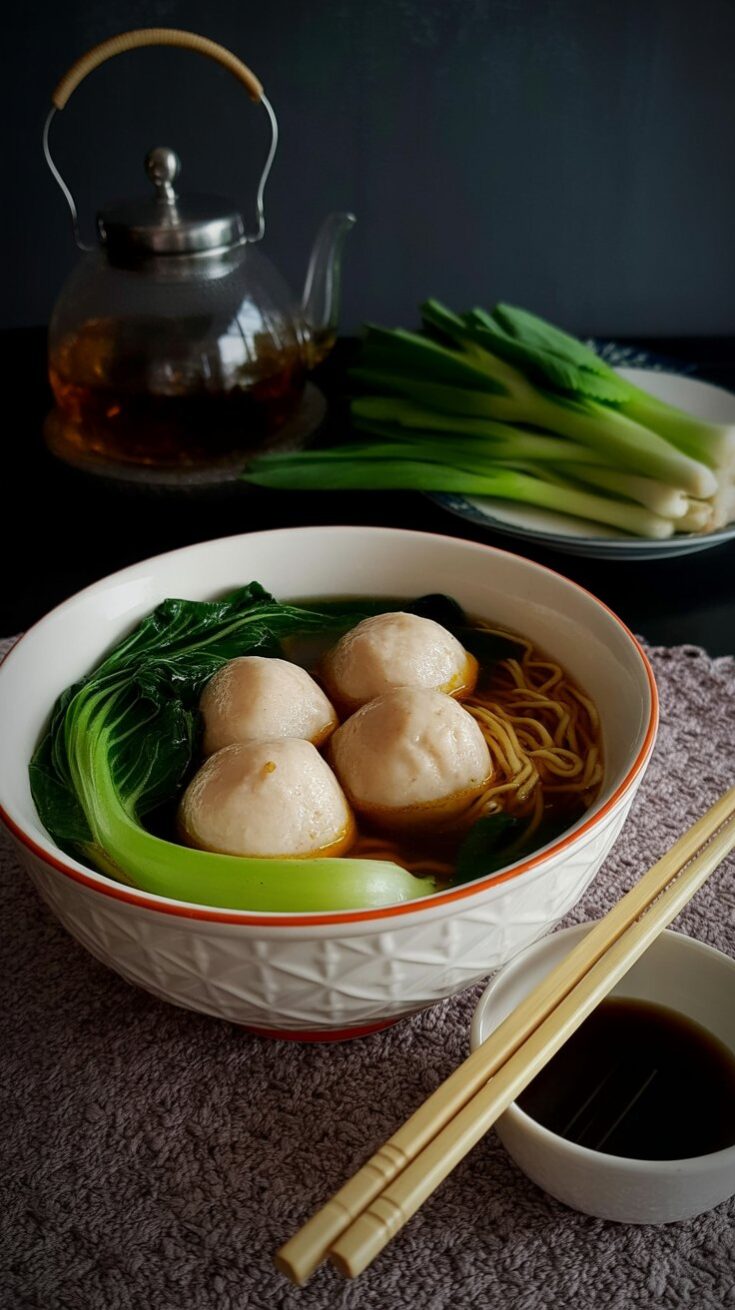Growing up, fishballs were a comfort food I could never get enough of. Whether floating in a steaming bowl of noodle soup or skewered and fried at a hawker stall, they were always a treat. Making them at home takes me back to those flavors, and honestly, I find it deeply satisfying to roll out a batch in my own kitchen.

There’s something almost meditative about shaping them — one after another — and knowing they’ll be the star of a simple soup or a fun snack later in the day. If you’ve only ever had store-bought fishballs, I promise homemade ones are worth the little bit of effort. They’re springy, fresh, and so much more flavorful.
What Fish Works Best
Traditionally, fish like wolf herring or Spanish mackerel are used, but those can be tricky to find outside Asia. At home, I’ve made great fishballs with tilapia, cod, bass, and even catfish. The fresher the fish, the tastier the end result.
My personal trick is to ask the fishmonger to fillet and skin the fish for me. That way, all I need to do is blitz it in the food processor when I get home. It makes the process so much easier, and it saves me from scraping the flesh off the skin, which can be a bit messy.
How I Get That Signature Bounce
The secret to bouncy fishballs lies in how the paste is worked. Traditionally, you’d pound the mixture by hand and throw it down on the counter 50–60 times. I’ve tried it that way, but to be honest, my food processor does the job beautifully and saves my arms.
Once the paste looks smooth and sticky, it’s ready. That stickiness is your sign that the proteins are binding well, which means springy fishballs once cooked.
Shaping the Fishballs
I still stick with the classic method for shaping: scoop some paste with a spoon, squeeze it between your thumb and forefinger, and you’ll get a neat little ball that drops straight into water. It takes a few tries to get the hang of it, but after a couple, you’ll be moving like a pro.
If you’d rather keep things simple, just roll them between your palms like regular meatballs. Either way, you’ll end up with glossy little rounds ready for cooking.

Ways I Love Using Fishballs
-
In soups – I love dropping them into a light broth with noodles and veggies. They soak up the flavors beautifully.
-
Stir-fries and fried rice – Slice them into halves or quarters and toss them in at the end for extra protein.
-
Pan-fried – A quick shallow fry gives them a golden crust that makes them perfect for snacking.
-
On skewers – This takes me back to Malaysian night markets. Grilled fishball skewers brushed with a little sauce make fantastic street food–style snacks at home.
Sometimes I even use leftover fishball paste to make flat fishcakes, which are equally handy for noodle soups or quick pan-frying.
Tips That Help Me Every Time
-
Keep everything cold – Chilled fish and cold water help the paste bind better.
-
Season lightly – A little white pepper and salt go a long way; you want the fish flavor to shine.
-
Cook a test ball – Drop one into simmering water first to check the texture and seasoning before shaping the whole batch.
-
Don’t boil too hard – Let them simmer gently; a rolling boil can make them tough.
Storage and Make-Ahead
Fishballs freeze beautifully. I usually freeze them raw after shaping — just lay them on a tray until solid, then pop them into a freezer bag. They’ll keep for about a month, and you can cook them straight from frozen.
Cooked fishballs last about three days in the fridge. I like to reheat them in broth or lightly pan-fry them to bring back that springy bite.

FAQs About Chinese Fishballs
Do I need a special type of fish?
No — any firm white fish works. Cod, tilapia, or bass are easy options if you can’t find mackerel.
Why aren’t my fishballs bouncy?
Usually, the paste hasn’t been worked enough. Make sure it’s smooth, sticky, and elastic before shaping.
Can I add other flavors?
Yes, some people mix in garlic, ginger, or spring onions. I like keeping them plain so they work in more dishes, then adding flavor in the broth or sauce later.
Do fishballs need binders like egg or cornstarch?
Not always. If your paste is worked properly, the proteins will bind on their own. That said, a little cornstarch can help if your fish is very lean.
How do I know when they’re cooked?
They’ll float to the surface of simmering water when done, usually in 3–5 minutes.
Homemade Chinese Fishballs

These homemade Chinese fishballs are glossy, springy little bites of flavor—perfect for soups, noodles, stir-fries, or sambals.
Ingredients
- 500 g white fish fillet
- 1 teaspoon salt
- ½ teaspoon ground white pepper
- ½ cup water
Instructions
- Begin by mincing the fish until finely ground. Transfer it to a food processor with the salt, pepper, and water. Blend on low speed for about two minutes, then increase to medium and continue mixing until the paste becomes smooth and sticky.
- If making by hand, place the fish and seasonings in a large bowl. Mix thoroughly with your hands, then lift the mixture and slap it down firmly against the counter or board. Repeat this around sixty times until the paste develops a springy, elastic texture.
- Keep a bowl of iced water nearby for shaping and a smaller bowl of cold water for dipping your hands. Form the paste into small balls, rolling between your palms or shaping them traditionally, and drop each into the bowl of iced water until ready to cook.
- To cook, bring a pot of water to a gentle boil and stir in a tablespoon of salt. Lower the heat to medium and slip in the fishballs, about ten at a time. They are ready once they rise to the surface, usually in two to three minutes. Remove with a slotted spoon and set aside.
- These bouncy fishballs are now ready to enjoy in soups, noodles, stir-fries, or any dish that calls for a savory, springy bite.
Nutrition Information
Yield
4Serving Size
1Amount Per Serving Calories 137Total Fat 1gSaturated Fat 0gTrans Fat 0gUnsaturated Fat 0gCholesterol 118mgSodium 671mgCarbohydrates 0gFiber 0gSugar 0gProtein 30g
Easy Shrimp Recipes.com, occasionally offers nutritional information for recipes contained on this site. This information is provided as a courtesy and is an estimate only. This information comes from online calculators. Although allchickenrecipes.com attempts to provide accurate nutritional information, these figures are only estimates.
Final Thought
Making homemade Chinese fishballs might sound intimidating at first, but once you try it, you’ll see how simple (and fun) it really is. The reward is a batch of fresh, springy little bites you can use in everything from soups to stir-fries. For me, it’s a way of bringing a piece of Asian street food culture right into my kitchen — and once you taste them, I think you’ll want to keep a stash in your freezer too.

